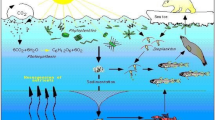We study the dynamics of age structure of the populations of copepods with the help of a chemicobiological model of shallow-water ecosystems developed on the basis of the technology of object-based modeling of marine ecological systems. The role of a prototype of the model species of copepods is played by Euterpina acutifrons (order Harpacticoida). The detailed analysis of parametrizations used for the description of the life cycle of this species is presented. We analyze the results of numerical experiments devoted to the investigation of a generation of copepods starting from the first stage of development, formation of a stationary age structure under various temperature and trophic conditions, and the appearance of population waves caused by the action of destabilizing factors on the population.
Similar content being viewed by others
References
E. F. Vasechkina and V. D. Yarin, “Object-based modeling of the coastal marine ecosystem,” Morsk. Gidrofiz. Zh., No. 5, 53–78 (2009).
E. F. Vasechkina and V. D. Yarin, “Modeling of the formation and propagation of hypoxia in the shallow-water zone,” Morsk. Ékol. Zh., 5, No. 3, 57–69 (2006).
E. F. Vasechkina and V. D. Yarin, “Object-based chemicobiological model of the shallow-water ecosystem,” in: Ecological Safety of the Coastal and Shelf Zones and Complex Utilization of the Shelf Resources [in Russian], Marine Hydrophysical Institute, Ukrainian National Academy of Sciences, Sevastopol (2007), pp. 41–51.
E. F. Vasechkina, “Integral model of the active layer of the Black Sea,” Morsk. Gidrofiz. Zh., No. 6, 23–29 (1985).
E. V. Yakushev, L. N. Neretin, and I. I. Volkov, “Mathematical modeling of the transformations of compounds of nitrogen and reduced sulfur under aerobic, anaerobic, and transient conditions for the example of the Black-Sea redox zone,” Geokhimiya, No. 10, 1489–1502 (1994).
F. Carlotti and A. Sciandra, “Population dynamics model of Euterpina acutifrons (Copepoda: Harpacticoida) coupling, individual growth, and larval development,” Mar. Ecol. Prog., Ser. 56, 225–242 (1989).
F. Carlotti and P. Nival, “Model of copepod growth and development: moulting and mortality in relation to physiological processes during an individual moult cycle,” Mar. Ecol. Prog., Ser. 84, 219–233 (1992).
K. M. Khailov and A. E. Popov, “Concentration of living mass as a regulator of functioning of aquatic organisms,” Ékol. Morya, No. 15, 3–15 (1983).
K. M. Khailov, A. V. Prazukin, N. I. Minkina, et al., “Concentration and functional activity of living substance in the accumulations of various levels of organization,” Usp. Sovrem. Biol., 119, No. 1, 3–14 (1999).
V. G. Dvoretskii and N. A. Pakhomova, “Comparative characteristic of the populations of Oithona similis (Claus) in waters of the Pechora Sea and in the coastal zone of East Murman,” Vestn. MGTU, 9, No. 5, 797–804 (2006).
Author information
Authors and Affiliations
Additional information
Translated from Morskoi Gidrofizicheskii Zhurnal, No. 1, pp. 63–80, January–February, 2010.
Rights and permissions
About this article
Cite this article
Vasechkina, E.F., Yarin, V.D. Modeling of the dynamics of age structure of the populations of free-floating copepods in the Black Sea. Phys Oceanogr 20, 58–74 (2010). https://doi.org/10.1007/s11110-010-9067-1
Received:
Published:
Issue Date:
DOI: https://doi.org/10.1007/s11110-010-9067-1




